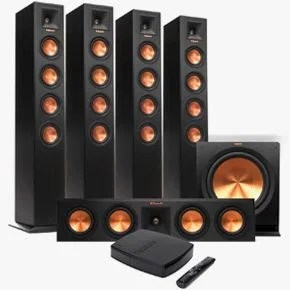The idea behind Klipsch’s Reference Premiere HD Wireless system, released this month, was simple: create a multi-channel home theater system that’s as easy to set up as a soundbar. “We call it the ‘cold beer setup,’” says Tony Ostrom, VP of product development for systems at Klipsch. “Once the product is unboxed, we wanted you to be able to open a cold beer and assemble the entire system before the beer got warm.”
At GP’s headquarters in NYC, with the 5.1 HD Wireless system in front of us, Ostrom’s statement sounded like a challenge.
Klipsch has been a part of the audio industry since 1946, and it is best known for a respected range of home theater products, such as the Reference line of passive loudspeakers that pump out audio with high efficiency, low distortion and lots of output. However, more recently, Klipsch has transitioned away from its classic “big-boxed” speaker roots, delving deep into wireless technology. At CES 2016 this past January, Klipsch didn’t have a single AV receiver at their booth.
“We call it the ‘cold beer setup.’ Once the product is unboxed, we wanted you to be able to open a cold beer and assemble the entire system before the beer got warm.”
The big pivot came with a partnership with the Wireless Speaker & Audio (WiSA) Association, a deal inked in 2011. This partnership allowed Klipsch to integrate WiSA’s wireless technology into their products, and now, in 2016, the Reference Premiere HD Wireless is Klipsch’s first wireless (meaning integrated with WiSA) high-definition home theater system. The HD Wireless system looks and sounds almost identical to Klipsch’s high-end Reference Premiere, released in 2015. Both systems feature the brand’s 90×90 Hybrid Tractrix horn technology (improving high-frequency response) and Linear Travel Suspension (LTS) titanium tweeters. The only major difference? The HD Wireless system has WiSA.
The advantages of WiSA technology are widespread. First, there are no wires connecting speakers. Each speaker still needs to be plugged into a power source, but the arduous process of running lines from receiver to speaker, under carpets or through walls, is gone. And, even better, every driver in each individual speaker has its own amplifier channel. To clarify: there are five channels of amplification in each of the HD Wireless’s floor-standing speakers, and five more in its center channel speaker; Klipsch’s electronics then allow users to control each driver, within each speaker, independently. From a dynamic perspective, says Ostrom, the listener’s complete control over the signal, and therefore the ability to extract every ounce of performance from all the speakers around the room, is better than it could ever be in a traditionally designed system.
Klipsch Reference Premiere HD Wireless System

